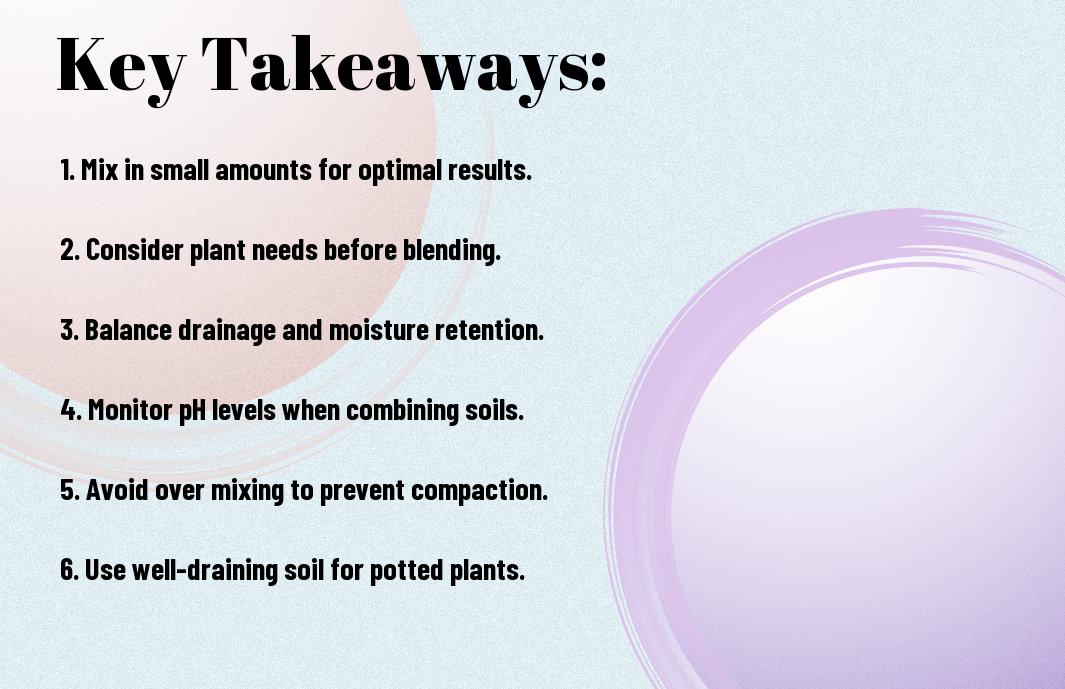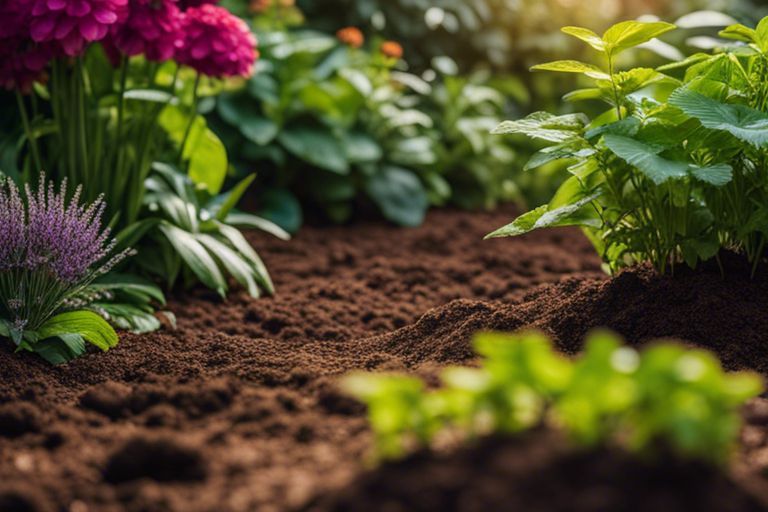You may be wondering if it’s possible to mix potting soil with garden soil for your planting needs. Garden soil and potting soil serve different purposes and have unique compositions, so it’s important to understand the implications of blending them together. In this informative blog post, we will explore into the differences between potting soil and garden soil, explore the benefits and potential drawbacks of mixing them, and provide expert recommendations on how to effectively combine these soil types for your gardening projects.
Key Takeaways:
- It is not recommended to mix potting soil with garden soil. Potting soil is specifically formulated for container gardening, while garden soil is meant for in-ground planting. Mixing the two can lead to poor drainage and nutrient imbalances.
- Each type of soil serves a specific purpose. Potting soil is lighter and provides better aeration for roots, while garden soil is heavier and retains more water. Using the appropriate soil for each type of planting will help your plants thrive.
- Consider using a blend of potting soil and compost for container gardening. This combination can provide the necessary nutrients, moisture retention, and drainage for healthy plant growth in containers.

Types of Soil
Even though potting soil and garden soil both serve as imperative components for plant growth, they have distinct characteristics that differentiate them. It is important to understand the differences between these soil types to determine if they can be successfully mixed together.
- Loam soil: A balanced mixture of sand, silt, and clay
- Sandy soil: Fast-draining soil with low nutrient retention
- Clay soil: Heavy soil with high nutrient retention but poor drainage
- Peat-based soil: Acidic soil with high organic matter content
- Silt soil: Smooth soil particles that hold moisture well
This table illustrates the basic characteristics of different soil types, which can help gardeners decide on the most suitable soil type for their plants.
Characteristics of Potting Soil
Soil used in pots and containers, potting soil is specifically designed to provide plants with adequate drainage, aeration, and nutrients. It is usually a mixture of organic materials like peat moss, compost, and perlite, which help retain moisture and promote healthy root growth.
Characteristics of Garden Soil
To understand the characteristics of garden soil, one must consider the unique composition of sand, silt, and clay particles present in it. Garden soil is typically richer in nutrients than potting soil, making it ideal for fostering robust plant growth in outdoor settings. This soil type may require amendments to improve drainage and structure, depending on its composition and the plants being grown.

Benefits and Drawbacks of Mixing Soils
Advantages of Soil Mixing
Many gardeners find that mixing potting soil with garden soil can offer the best of both worlds. By combining the two types of soil, you can create a blend that has the necessary nutrients and structure for healthy plant growth while also providing good drainage and aeration.
Potential Issues with Mixed Soils
To ensure successful plant growth when mixing potting soil with garden soil, it’s necessary to consider the differences in texture, pH levels, and nutrient content between the two. Mixing soils without considering these factors can lead to poor drainage, nutrient deficiencies, or even plant stress.
Another important consideration when mixing soils is the risk of introducing pests, diseases, or weed seeds from one type of soil to another. It’s crucial to use quality soil and sterile containers to prevent contamination and ensure the health of your plants.

How to Mix Soils Effectively
Preparing the Soils for Mixing
With any soil mixing project, it’s vital to start by preparing the soils properly. This involves ensuring both the potting soil and garden soil are of good quality and free from any contaminants or pests. Additionally, it’s crucial to assess the nutrient levels in both soils to determine if any amendments are needed before mixing.
Methods for Combining Potting Soil with Garden Soil
Potting soil and garden soil can be effectively combined using various methods. One common approach is to mix the two soils in a large container or wheelbarrow, ensuring they are thoroughly blended. Another method is to layer the potting soil and garden soil in the planting area, allowing them to naturally mix over time as you plant and water your garden.
Effectively combining potting soil with garden soil is vital for creating a balanced growing medium for your plants. This process involves ensuring the soils are mixed evenly to promote proper drainage, aeration, and nutrient distribution. By following the right methods, you can achieve a healthy and fertile soil mix that will support vigorous plant growth in your garden.
Application and Care
Best Practices for Using Mixed Soil in Gardens
On the day of planting, ensure the mixed soil is well-moistened but not soaked. Make sure to mix it thoroughly with the existing soil in the garden bed to avoid creating barriers that could impact root growth. Monitor drainage to prevent waterlogging, especially in areas with heavy rainfall.
Maintenance and Monitoring Soil Quality
Soil quality maintenance is crucial for the long-term health of your garden. Regularly test the soil pH levels and nutrient content to ensure they meet the needs of your plants. Keep an eye out for signs of compaction or erosion, and address them promptly to avoid nutrient deficiencies and water runoff.
Best practices also include mulching your garden beds to help retain moisture, regulate soil temperature, and suppress weed growth. Regularly inspect your plants for any signs of nutrient deficiencies or pest infestations, and take appropriate action to prevent further damage to your garden.
To wrap up
Drawing together potting soil and garden soil can be done, but it is imperative to understand the differences and consider the specific needs of your plants. Potting soil is lightweight and well-draining, ideal for containers, while garden soil is heavier and more suited for in-ground planting. Mixing the two can help strike a balance for certain plants that may benefit from a blend of both. However, it is crucial to monitor drainage, nutrients, and pH levels to ensure optimal growing conditions. Overall, blending potting soil with garden soil can be a viable option with careful consideration and attention to your plants’ requirements.
FAQ
Q: Can I mix potting soil with garden soil?
A: Yes, you can mix potting soil with garden soil to improve the quality of both. This combination can provide better drainage, aeration, and nutrient balance for your plants.
Q: How much potting soil should I mix with garden soil?
A: It is recommended to mix potting soil with garden soil in a 1:1 ratio. This will ensure a good balance of organic matter, nutrients, and drainage for your plants.
Q: What are the benefits of mixing potting soil with garden soil?
A: Mixing potting soil with garden soil helps improve soil structure, water retention, drainage, and nutrient availability. It can enhance plant growth and support healthy root development.
Q: Can mixing potting soil with garden soil help with container gardening?
A: Yes, mixing potting soil with garden soil can be beneficial for container gardening. It can improve the quality of the soil in containers, providing better conditions for plant growth and development.
Q: Are there any plants that do not do well with a mix of potting soil and garden soil?
A: While most plants benefit from a mix of potting soil and garden soil, some plants may have specific soil requirements that are not met by this combination. It is important to research the soil needs of individual plants before mixing soils for them.
